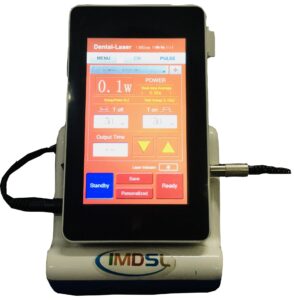Dental Laser – Myths Vs. Reality : Debunking Misconceptions and Embracing the Reality in Modern Dentistry
When we talk about Dental Laser – Myths Vs. Reality , Dental laser technology has advanced significantly over the past few decades, offering numerous benefits in various dental procedures.

However, like any innovation, misconceptions and myths can cloud the perception of this powerful tool. In this blog, we will address common myths surrounding dental lasers and shed light on the reality, aiming to educate dentists about the true potential and limitations of this technology.
Myth #1: Dental Lasers Are a Fad
Reality: Dental lasers are here to stay, with a growing body of evidence supporting their effectiveness. They have been used in dentistry for more than two decades and are now considered an integral part of modern dental practice.
Lasers offer unique advantages, such as precision, less pain, and faster healing, making them indispensable for various procedures, from soft tissue management to hard tissue treatments.
Myth #2: Dental Lasers Are Unsafe
Reality: Laser safety is a top priority in dental practice. When used correctly, dental lasers are safe for both patients and practitioners. Laser manufacturers adhere to strict safety guidelines and provide thorough training to dentists.
Moreover, the risk of damage to surrounding tissues is minimal due to the precise targeting of the laser. However, proper education and certification are essential for all dentists wishing to integrate lasers into their practice.
Myth #3: Dental Lasers Are Too Expensive
Reality: While it’s true that dental laser equipment can be a significant investment, the long-term benefits far outweigh the initial cost.
The cost-effectiveness of dental lasers becomes evident as they reduce the need for anesthesia, minimize chair time, and enhance patient satisfaction. Additionally, many financing options and tax incentives are available to help dentists make this valuable addition to their practice.
Myth #4: Dental Lasers Are Only for Specific Procedures
Reality: Dental lasers are versatile tools suitable for an array of procedures. They can be used for soft tissue treatments, such as gum contouring and frenectomies, as well as hard tissue procedures like cavity preparation and root canal sterilization.
Lasers are also valuable in oral surgery, periodontics, and even cosmetic dentistry. Dentists can tailor their laser use to suit their practice’s specific needs.
Myth #5: Dental Lasers Are Painful for Patients
Reality: In reality, dental lasers often result in less pain for patients compared to traditional methods. Lasers seal nerve endings, reducing post-operative discomfort. Patients often experience minimal bleeding and swelling, and the need for anesthesia is significantly reduced in many cases. This translates to a more comfortable experience for patients and higher patient satisfaction.
Myth #6: Anyone Can Use Dental Lasers
Reality: Laser dentistry requires specialized training and certification. Dentists must learn the intricacies of different laser systems, understand tissue interactions, and grasp safety protocols.
It is essential for practitioners to undertake comprehensive training to ensure they can harness the full potential of dental lasers while providing safe and effective treatments.
Myth #7: Dental Lasers Can Replace Traditional Tools Completely
Reality: While dental lasers are incredibly valuable, they are not a complete replacement for traditional dental tools. Dentists often use a combination of lasers and traditional methods to achieve the best results. Each tool has its own strengths, and dentists should choose the right approach for each unique case.
Dental lasers have come a long way from being perceived as a novel technology to becoming a trusted and indispensable part of modern dentistry.
It is vital for dentists to dispel the myths surrounding dental lasers and embrace the reality of their benefits and limitations. By doing so, they can provide their patients with the best possible care, while also staying at the forefront of dental innovation.
Proper education, training, and the integration of laser technology into dental practice will undoubtedly benefit both dentists and their patients in the long run.


Comments